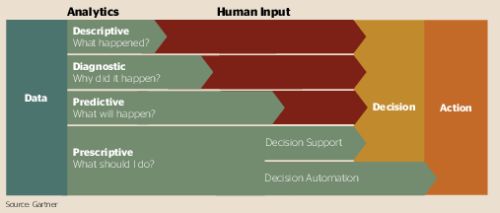Published on the 16/09/2014 | Written by Ian Bertram

The terms BI, BA and big data tend to be unceremoniously bandied about without much consensus on what they are. Gartner’s Ian Bertram, separates the myth from the truth…
BI or BA: what is the difference between business analytics and business intelligence and should we care?
In simple terms, business analytics is the new term that describes the activity or capability within the organisation to turn data into actions. Business intelligence has been part of those activities and capabilities and, while still a relevant term today, many use this to describe just the reports that feed the decisions that will lead to an action.
The business of analytics
Analytics is a discipline that applies logic and mathematics to data to provide insights for making better decisions. Many still struggle to understand the different analytical capabilities that can be leveraged.
In ‘Extend your portfolio of analytics capabilities’, Gartner defines four styles of analytics: descriptive, diagnostic, predictive, and prescriptive.
Descriptive analytics shows what is currently happening or has happened. It applies decisionmaking, so needs a human to be involved. All those reports that have been generated over the years – what some would call business intelligence – are actually descriptive analytics in practice.
Diagnostic analytics helps us understand why outcomes, events or trends occurred. This involves techniques such as visualisation, which leads to more questions and more insights, bringing you closer to a good decision. In business intelligence terms, this is known as Service BI, delivering discovery capabilities to different users within an organisation.
Predictive analytics anticipates future behaviour or estimates unknown outcomes. It tells us what will happen, anticipating future outcomes based on patterns that have been modelled, generated or detected. Some predictive analytics can even learn, giving us hints towards the right decisions that need to be made.
Prescriptive analytics specifies a preferred course of action. This applies both to situations when a human is in the loop, and for decision automation, when a system automatically carries out an action.
What many knew as business intelligence is really just the first two layers described above. It’s important to develop a portfolio of capabilities, often used together to address a wide range of problems.
The big data mess
By adding the term ‘big data’ into the mix, the waters get increasingly muddy. There is still a lot of ambiguity around what big data actually is and what value it brings to an organisation.
In a recent blog post I wrote after visiting clients in Asia, I responded to a question about how big the big data market is by pointing out there is actually no such thing as a big data market. It’s not a product or a service or a solution. It’s a concept that refers to a large volume of unstructured data which cannot be handled by standard database management systems.
However, there are technologies already accounted for in other areas that have the potential to make up a solution that deals with big data. For example, hardware components cater for high-volume storage and high movement of data. Organisations could be using these components today and not calling it big data. Big data technologies supplement – but do not replace – existing information management and analytics systems.
The starting point for any organisation is to work out what outcome it is trying to achieve. By knowing the desired outcome, you can reverse engineer the process to come up with the relevant questions that need to be asked. This then generates the relevant information needed to help give insight into the question.
I deliberately used the word ‘relevant’ because the challenge of handling big data is only going to continue to grow for many organisations, but will start to become easier once users understand what information is relevant to understanding the situations their business is facing.
Big data investments continued to rise, with 64 percent of organisations investing or planning to invest in technology for big data. However, fewer than eight percent have actually deployed that technology. Investments were led by organisations in the media and communications sectors, followed by banking and services.
When it comes to big data projects, unlike most business intelligence projects, the benefits are not just in decision making. Rather, these projects are geared to generate deeper business insights and optimise, automate or even design new processes. The range of uses spans marketing and sales growth; operational and financial performance improvement; risk and compliance management; new product and service innovation; and even direct/indirect data monetisation. Most often, value comes from combining diverse data to uncover patterns, links or phenomena that hasn’t previously been seen before.
The real question is: what value are organisations obtaining from looking at their data sources differently?
 ABOUT IAN BERTRAM//
ABOUT IAN BERTRAM//
Ian Bertram is managing VP of Gartner’s analytics and business intelligence research team and head of research for Asia Pacific. Based in Sydney, he leads a global team of analysts who publish research and advise clients on analytics, business intelligence, information management, big data and performance management. Prior to joining Gartner, he was with IBM for 10 years.
FURTHER READING

From manual to modern planning processes
Making the business case…

Whitepaper: Data warehouse automation and ERP
The benefits of incorporating a data warehouse when upgrading your ERP…

Whitepaper: How to futureproof your financial report builds
Make sure financial reporting doesn’t get left behind in your ERP implementation…

Five key factors to consider when evaluating financial reporting software
So you can get a BI solution that can fully handle the complex structure of financial data…

Five Excel tips for better budgeting and forecasting
It isn’t perfect, but some of the challenges of using the software have more to do with the user’s lack of expertise…




























